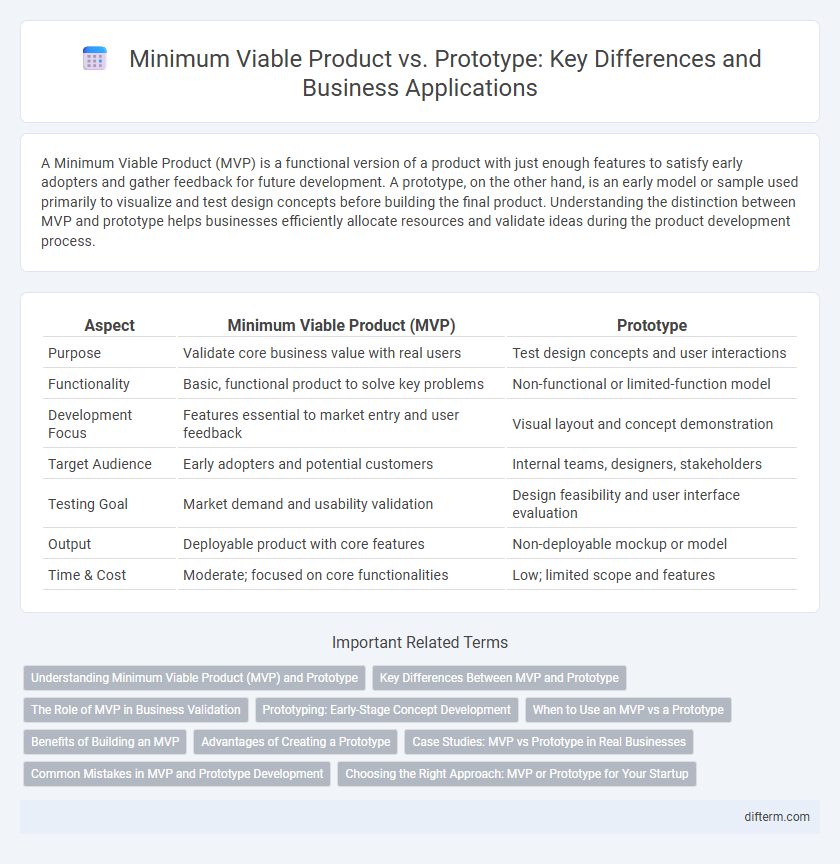A Minimum Viable Product (MVP) is a functional version of a product with just enough features to satisfy early adopters and gather feedback for future development. A prototype, on the other hand, is an early model or sample used primarily to visualize and test design concepts before building the final product. Understanding the distinction between MVP and prototype helps businesses efficiently allocate resources and validate ideas during the product development process.
Table of Comparison
| Aspect | Minimum Viable Product (MVP) | Prototype |
|---|---|---|
| Purpose | Validate core business value with real users | Test design concepts and user interactions |
| Functionality | Basic, functional product to solve key problems | Non-functional or limited-function model |
| Development Focus | Features essential to market entry and user feedback | Visual layout and concept demonstration |
| Target Audience | Early adopters and potential customers | Internal teams, designers, stakeholders |
| Testing Goal | Market demand and usability validation | Design feasibility and user interface evaluation |
| Output | Deployable product with core features | Non-deployable mockup or model |
| Time & Cost | Moderate; focused on core functionalities | Low; limited scope and features |
Understanding Minimum Viable Product (MVP) and Prototype
A Minimum Viable Product (MVP) is a functional version of a product that includes only the essential features necessary to satisfy early adopters and gather user feedback for future development. In contrast, a prototype serves as an initial model or simulation designed primarily to test concepts, design, and feasibility without full operational capabilities. Understanding the difference between an MVP and a prototype is crucial for businesses to allocate resources effectively and accelerate product-market fit.
Key Differences Between MVP and Prototype
A Minimum Viable Product (MVP) is a functional version of a product designed to test market demand with core features, while a prototype is an early sample or model used primarily for design and usability testing. MVPs aim to gather real user feedback and validate business hypotheses, focusing on delivering value to early adopters. Prototypes serve as visual or interactive drafts without full functionality, primarily to refine ideas and identify design flaws before development.
The Role of MVP in Business Validation
Minimum Viable Product (MVP) functions as a crucial tool for business validation by delivering the most basic version of a product that addresses core customer needs, enabling real-world testing and feedback collection. Unlike a prototype, which serves primarily as a preliminary model to demonstrate concepts or test feasibility, MVPs allow startups and businesses to validate market demand, refine product features, and reduce time-to-market risk. This iterative approach accelerates informed decision-making, saving resources by focusing on validated solutions rather than assumptions.
Prototyping: Early-Stage Concept Development
Prototyping facilitates early-stage concept development by creating tangible models that allow stakeholders to visualize and test ideas before full-scale production. It enables rapid iteration, identifying design flaws and user feedback early in the development cycle. This approach minimizes risks and refines functionality, ensuring alignment with customer needs prior to advancing to a minimum viable product (MVP).
When to Use an MVP vs a Prototype
A Minimum Viable Product (MVP) is best used when validating core business assumptions and testing market demand with a functional solution that includes essential features. Prototypes are ideal during the early design phase to explore concepts, gather user feedback, and refine product ideas without full functionality. Choose an MVP to launch quickly and adapt based on real customer usage, while prototypes serve to visualize and iterate on design hypotheses before development.
Benefits of Building an MVP
Building a Minimum Viable Product (MVP) accelerates market entry by focusing on core features that address customer pain points, allowing businesses to validate their ideas with minimal investment. MVPs enable real user feedback, reducing the risk of product failure and guiding iterative improvements based on actual demand. This lean approach conserves resources while facilitating faster pivoting and scaling opportunities, boosting overall product-market fit success.
Advantages of Creating a Prototype
Creating a prototype offers tangible advantages such as enabling early visualization and hands-on testing of design concepts, which helps identify potential flaws before full-scale development. Prototypes facilitate better stakeholder communication and feedback, reducing misinterpretations and aligning expectations with actual product capabilities. This iterative process decreases costly revisions, accelerates time-to-market, and ultimately enhances product quality and user satisfaction.
Case Studies: MVP vs Prototype in Real Businesses
Case studies reveal that companies like Dropbox leveraged Minimum Viable Products (MVPs) to validate market demand quickly with limited features, enabling rapid iteration based on user feedback. In contrast, firms such as Tesla use prototypes extensively during the product development phase to test design feasibility and engineering challenges before scaling production. These real-world examples demonstrate MVPs prioritize market learning and customer validation, whereas prototypes focus on technical validation and refining concepts.
Common Mistakes in MVP and Prototype Development
Common mistakes in Minimum Viable Product development include overbuilding features beyond core functionality, leading to wasted resources and delayed market entry. In prototype development, a frequent error is creating overly polished versions that mislead stakeholders about the product's readiness, diverting focus from user feedback. Both processes suffer when teams fail to clearly differentiate objectives, causing confusion between validating concepts (prototype) and testing market viability (MVP).
Choosing the Right Approach: MVP or Prototype for Your Startup
Selecting between a Minimum Viable Product (MVP) and a prototype hinges on your startup's goals and resources; an MVP delivers a functional version to test market demand and gather user feedback, while a prototype serves as an early visual or interactive model to validate concepts and design. Startups aiming for rapid market entry with validated features typically prioritize MVP development to minimize time-to-market and optimize product-market fit. Prototypes are ideal for refining user experience and securing stakeholder buy-in before investing in full-scale development, ensuring alignment with customer needs and technical feasibility.
Minimum Viable Product vs Prototype Infographic

 difterm.com
difterm.com